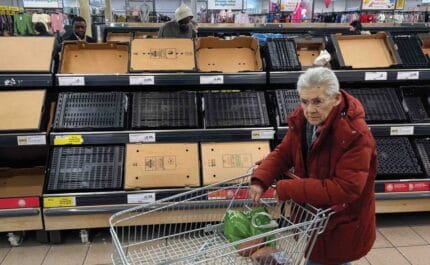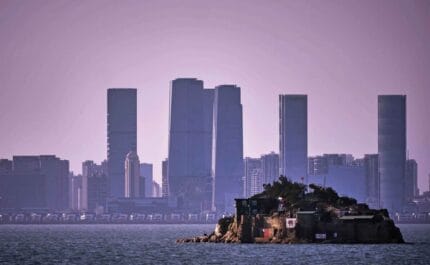The butterfly that roared
On 28th January, Colombia’s transitional war crimes tribunal delivered its first indictment against an armed group for crimes committed during the country’s bloody civil war. Four years after the peace accords were signed, the experiences of many Colombians during the conflict are only just coming to light. One of the stories emerging is that of Crisálida, an LGBTQ collective that was brutalised by paramilitary forces occupying the small town of San Rafael – but which has emerged defiant and demanding justice
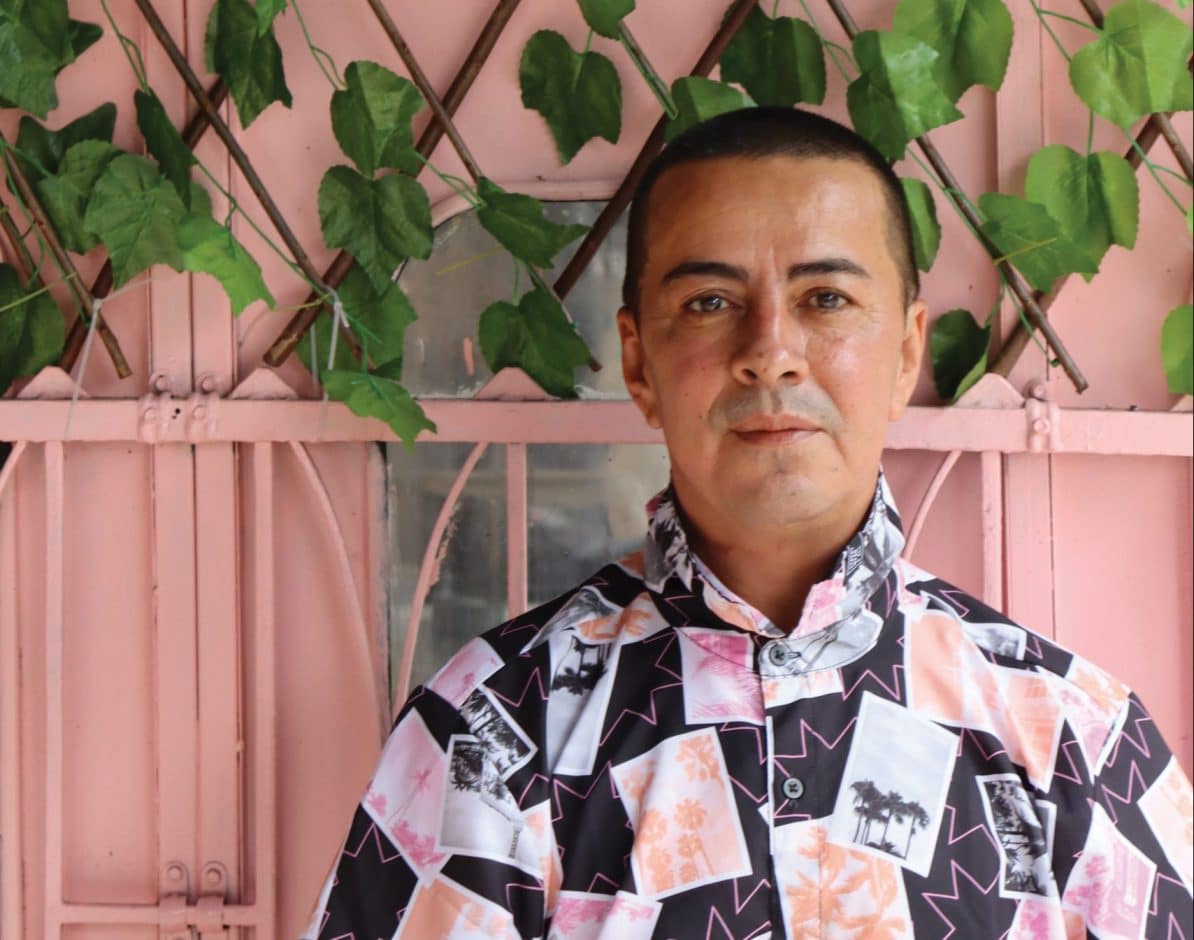
Benjamin Morales, aka 'Mincho', in San Rafael, Colombia. Photo: Emily Hart
28th January 2021 (Taken from: #42)
“The butterfly vanished… Our brave soul, who fought for the LGBTQ population of this beloved San Rafael, that fighter who never took no for an answer”
Extract from Chrysalis
Under a merciless sun, a small procession carries a quilt into a leafy square dominated by a church with a red and white façade. The clock in the tower reads ten to ten, though it is the middle of the afternoon.
The quilt is made from more than a hundred patches, each embroidered with the name of one of San Rafael’s conflict victims. Its bearers hang it carefully over the front of a stage. Memorials to the victims of Colombia’s civil war are all too familiar in a country that endured one of the longest internal conflicts of the 20th century. But this one is different.
Alongside the Colombian flag onstage is a huge rainbow flag, an unusual sight in rural Antioquia, one of Colombia’s most conservative regions. Next to the quilt hang photos of a man: in some he is captured mid-dance move, in a sparkling dress and lush blonde wig; in others, he is dressed in a school uniform, with dark brown pigtails down to his shoulders.
Carlos ‘Sardino’ Arboleda was the leader of a groundbreaking LGBTQ collective in this deceptively sleepy town, nestled amid the jungle-clad hills of the Andes in north-west Colombia. In the 1990s, Sardino forged an acceptance and representation for gay people that was totally unheard of at the time. In December 2000, he was killed by far-right paramilitary forces, a murder that stopped the progress in its tracks.
Today marks the launch of Chrysalis, a book about that brutal night, written by members of Sardino’s group, now known as the Colectivo Crisálida, the Chrysalis Collective. The story is recounted from the perspective of ‘Mincho’ and ‘Botero’, Sardino’s closest friends and colleagues. Somewhere between fable and memoir, the novel follows the two as they make their way through a dark cave accompanied by a butterfly guide. ‘Mariposa’ – butterfly – is an insult often levelled at gay men in Colombia: the Chrysalis Collective is reclaiming the word.
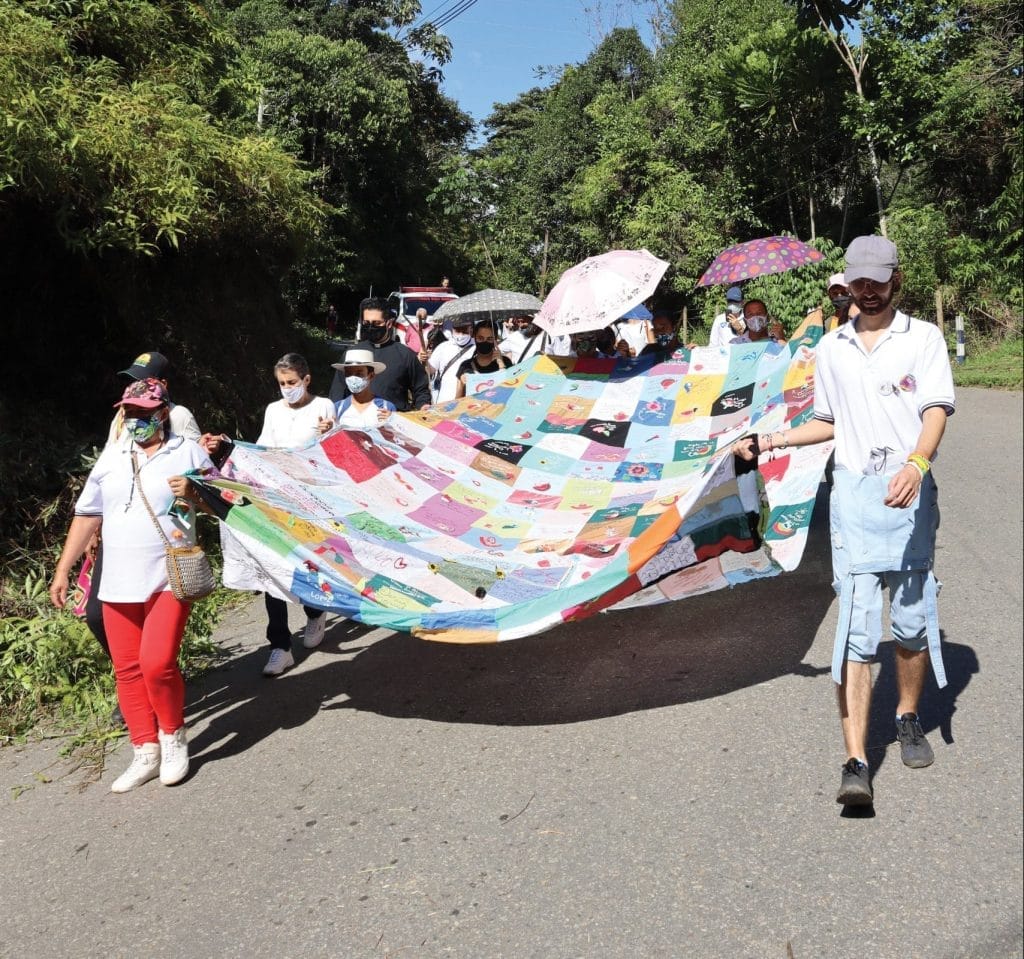
A quilt commemorating San Rafael’s conflict victims is paraded through the town
The real Mincho, Benjamin Morales, goes to stand by the stage, listening intently as passages are read out from the book. He moves with a quiet grace, his kind eyes framed by disarmingly perfect eyebrows. After the reading, we sit and drink a coffee together on the edge of the square. “The book tells our story so that it doesn’t happen again. Nobody
was able to report anything at the time,” says Mincho. “If you had, you’d have been killed – full stop. We are telling what we lived, so much of which was hidden.”
Rural Colombia was never an easy place to be gay. In most places, it still isn’t.
“I was one of 15 children. We were too poor to even have shoes for school, but I stood out in lots of other ways, too. I was called ‘fag’ and ‘butterfly’ from a very young age,” Mincho tells me. He and Sardino met in their teens through one of the town’s traditional dance groups and the two decided to create their own troupe: Sardino would be the director and Mincho the choreographer. They had no funding, but both were passionate about dancing, and they made costumes from whatever they could find.
Sardino won people over with his performances, drawing crowds with his drag renditions of ‘Don’t Cry for Me Argentina’”
“We were basically sisters. We loved dancing to Abba – Sardino’s sister went to Europe when we were teenagers and brought back some of their CDs. We listened to them over and over and over until we knew them by heart, all of the dances and all of the words.”
“When we started, the rejection of the community was really hard: when we danced in the square, even though we were in traditional dress, they would throw rotten tomatoes and meat offcuts at us. They would push us out of the park shouting ‘We don’t need you here!’”
Police harassment and arbitrary imprisonment were common experiences for gay people in Colombia in the mid-1980s, even though homosexuality had been decriminalised at the start of the decade. Sardino and his friends used to hide cigarettes in San Rafael’s sole police cell when they were arrested, knowing it would only be a matter of time before one of them was back in detention.
The group’s strategy was to win hearts and minds through culture, Mincho tells me: They went from participating in local events with their dance troupe to organising their own events and putting on shows. By bringing people together, performing folkloric dances and enriching the local cultural life, the group slowly became integrated into this small-town society. Sardino in particular won people over with charisma, his sense of fun and inclusivity and his own performances, drawing crowds with his drag renditions of ‘Don’t Cry for Me Argentina’.
Sardino was a leader, says Mincho, a man who changed the face of San Rafael. He was known for his style, always well dressed, with a penchant for patchouli perfumes, and was often seen riding around town on his bright yellow motorbike. The collective and its cultural activities offered a home for those who felt like outsiders, with community dinners and events at Sardino’s farmhouse, known as ‘Sardibella’.
And, little by little, acceptance was won: the group’s shows would eventually sell out, with people trying to peer in from the streets outside, and repeat performances demanded. They were invited to Cartagena to support the national Miss Colombia pageant, and were paid by local bars to show up in order to attract clientele and fill the dance floor. They were famed for always being ahead of fashion and dance trends.
“Through our shows we’d meet members of armed groups, even the famous ‘friends of Pablo Escobar,’” says Mincho, pausing and glancing at me sideways as he uses a Colombian euphemism for members of the Medellín cartel. “They’d come to San Rafael to hide out, although we never knew exactly who they were until years later.”
Sardino didn’t just lead the activities in the LGBTQ community; he was also at the centre of much of the town’s cultural life. His name peppers San Rafael’s yellowing local history books and archived event pamphlets thanks to his involvement in choreography, fashion shows, charitable projects and children’s dance groups, often with a focus on folkloric or traditional celebrations.
At one point, the local priest even invited the group to take part in church celebrations, and the LGBTQ community began organising San Rafael’s biggest annual festival, a celebration of the river which flows along the town’s southern edge. “The events attracted gay people from all over the area – people even began calling the town San Rafagay – but the wider community started accepting us too,” says Mincho.
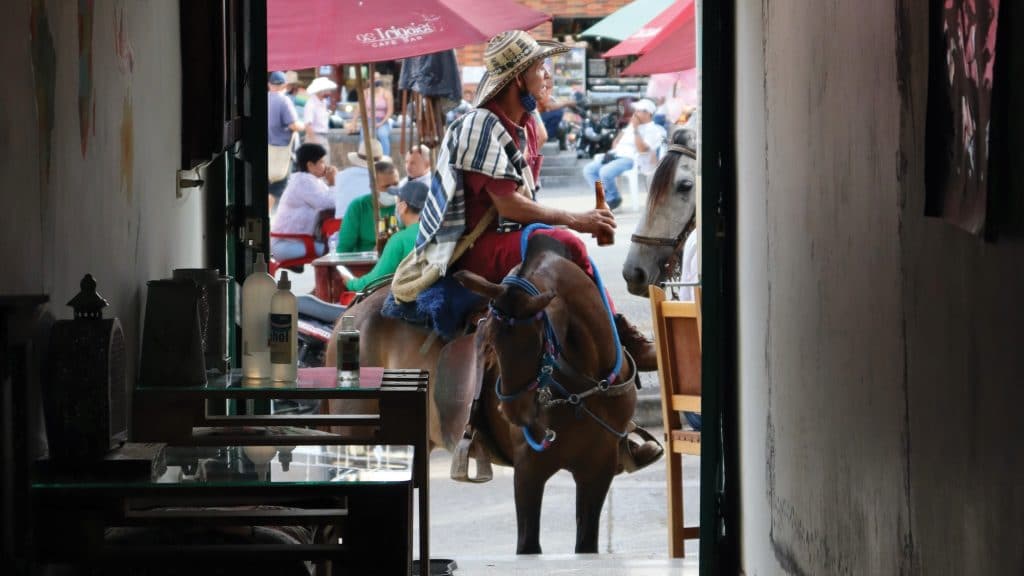
The rural town of San Rafael is in Antioquia, one of Colombia’s most conservative regions
Sardino organised the town’s first pageant: Omaira Garro was the first ever Miss San Rafael, crowned by popular vote in 1994. “I begged Sardino to let me join,” says Garro. Still strikingly beautiful, her face lights up with nostalgia when she talks about the event. “He said yes, and it changed my life. Sardino taught me everything – how to walk in high heels, practising with a book balanced on my head, all of it. Until I was 14, I lived out of town – we didn’t even have electricity.” Garro won national modelling contracts after the pageant, and went on to study law. But while Sardino’s Collective was growing its influence, civil conflict was rising in the background.
The Revolutionary Armed Forces of Colombia, a Marxist guerrilla group better known as the Farc, had arrived in the area in the 1980s, but didn’t bother the collective, and even showed up at a house where they had gathered to dance and make clothes. “Someone knocked at our door during a big party. It was the Farc guerrillas – about 20 armed men. They asked us what we were doing. A friend – wearing a dress made from a curtain – wandered into the doorway and simply told them, ‘We are just here, being homos.’ It made them laugh so much that they said, ‘Well, keep on being homos, guys.’ And they didn’t mess with us again,” says Mincho with a smile.
As Colombia’s conflict continued to escalate during the 1990s, the army, and subsequently the far-right AUC paramilitary group, took control of the town. The collective stood its ground as much as it could – until tragedy struck.
The conflict that would end up claiming Sardino’s life was a complicated and shifting kaleidoscope of armed groups, insurgent politics and vested interests – all of it played out over decades of violence and fed by intervention and support by the state, narco mafia and corrupt elites.
Some say Colombia’s true civil war began in the 1980s, others say it is just one of ten separate civil conflicts which have taken place since the mid-19th century. Some even claim the country has been in one near-continuous conflict since the civil war of 1860, in which a conservative confederation faced off against a liberal force from the Cauca region.
Sardino changed my life. Until I was 14, I lived out of town – we didn’t even have electricity”
A key turning point came in 1948, when the assassination of Liberal party leader Jorge Eliécer Gaitán prompted a new explosion of hostilities. Conservatives and Liberals killed each other all over the country and formed militias, both sides fighting under the chilling slogan No dejar ni la semilla (‘Don’t leave even the seed’), meaning that children and pregnant women were slaughtered. This ten-year period is known simply as La Violencia. Thousands died and many more fled the country to neighbouring Venezuela.
In an attempt to stop the fighting, in 1958 the Conservatives and Liberals created a power-sharing agreement called the National Front, in which they would take turns in power. Alienated by what they saw as the elites sewing up the government of Colombia, far-left guerrilla groups, including the Farc, the ELN and M-19 rose up in the 1960s and early 1970s, and began to take control of large parts of the country.
Counter-insurgency movements soon sprang up, notionally to protect communities from the guerrillas. Though armed groups and ‘self-defence’ militias had long been a part of Colombia’s landscape, this new generation was bolstered by unprecedented state support in the face of the threat posed by the Farc, the most powerful of the guerrilla groups. Though it had been a Conservative stronghold during La Violencia, the countryside around San Rafael became a rear-guard area for the Farc in the early 1980s, a place for soldiers to rest and get medical care. It also lay on a key corridor between Bogotá and Medellín, Colombia’s second city.
“Farc guerrillas would arrive at a house and say ‘We need you to kill ten chickens,’ and everyone would immediately get to work,” recalls Garro with a shudder. “I remember, sometimes, we didn’t have anything to give them, and my dad would put us under the bed, me and my brother, and he’d go out to meet them with a machete behind his back – the guerrillas always arrived with guns. As a child, it seemed to me that my dad could keep us safe. I look back now and it’s terrifying.” Demands for supplies, shelter and cash payments were a common part of the conflict, with armed groups describing them as ‘vaccinations’ which would gain you ‘immunity’ from violence.
In 1981, a new, nominally anti-guerrilla paramilitary group called MAS (Muerte a Secuestradores, ‘Death to Kidnappers’) was created and funded by a coalition of narco-traffickers and mafia bosses, including Pablo Escobar. Leading Colombian businessmen and American corporations were also part of its creation. A later government investigation linked 59 active military servicemen to the group.
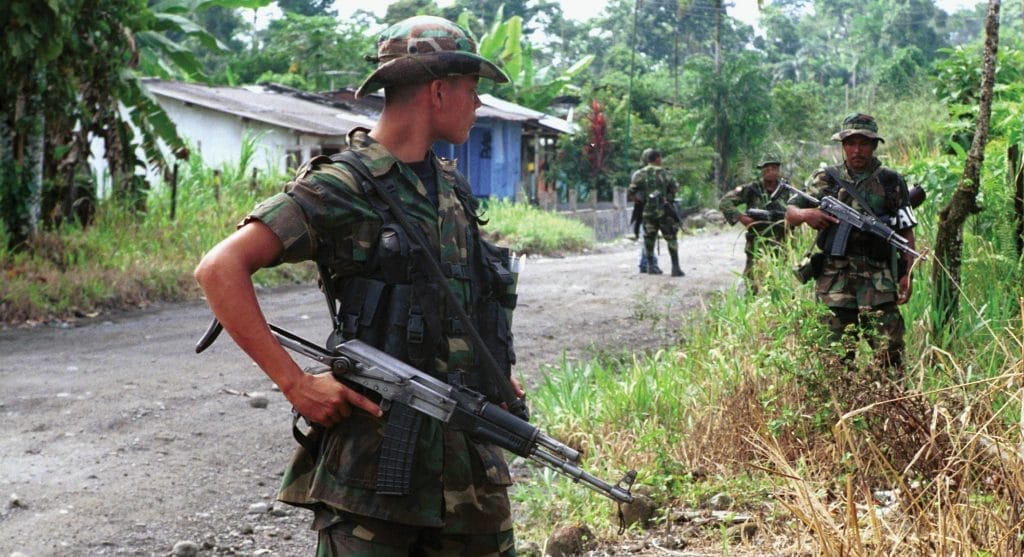
AUC paramilitary fighters on patrol in rural Colombia in 2000
Similar groups proliferated across the country and occupied huge territories. It was a new era of paramilitarism marked by increased resources and links to military, government and mafia. Activists were killed in their thousands, as well as journalists and even judges. Some of the victims were leftist insurgents or collaborators, but many simply stood in the way of the interests of the narcos, politicians and landowners who supported the paramilitaries.
In 1997, brothers Carlos and Vicente Castaño, paramilitary leaders and former members of Escobar’s Medellín cartel, united these groups in a coalition known as the ‘United Self-Defence Forces of Colombia’ – the AUC – which gained unprecedented power and strength. What followed was one of the bloodiest periods of Colombia’s history.
San Rafael’s reputation as a centre for Farc occupation made it a prime target for counter-insurgent paramilitaries as well as retribution by army and police. In 1998, the notorious ‘Metro Bloc’ unit of the AUC entered San Rafael, an event announced theatrically in advance via a tornado of fliers dropped from a helicopter. Complicity between the state and paramilitaries had been suspected during the 1980s, but the ease with which the AUC occupied the town confirmed those ties: they walked into the place “like a dog walks into its own home”, as they say in San Rafael.
Coexistence with the Farc guerrillas in San Rafael had been normalised to some extent, but the Metro Bloc’s occupation unleashed a new level of violence. Wilder Marín, now in his thirties and pastor of one of San Rafael’s six churches, remembers their arrival. “I was about 11 years old when armed groups started showing up in the town. Even at that age we knew how to identify and distinguish between the Farc and the paramilitaries,” he says. “The paramilitaries installed themselves in the town, always watching. They broke the streetlamps to make sure it was totally dark at night – darkness was a form of camouflage for them.”
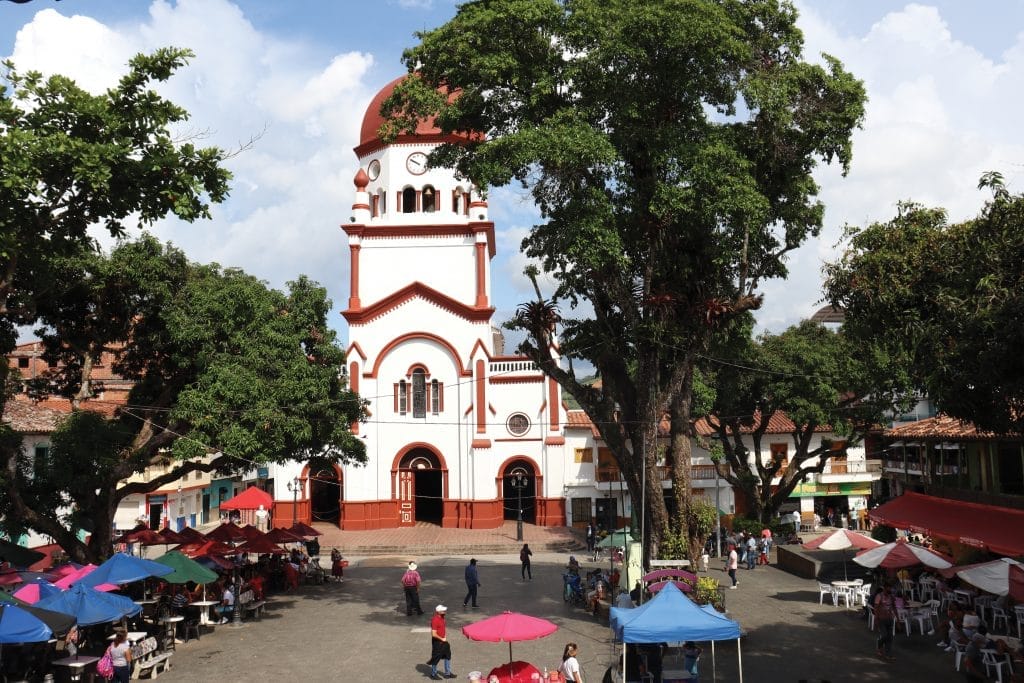
The town square of San Rafael, in which Farc and the AUC fought a battle in 1999
The AUC’s strategy comprised selective killings, threats and displacements to create an environment of terror and obedience. It planned to control the land and population and cut off the supply of resources to the Farc. In 1999, the Farc and the AUC fought a battle in the town square itself, firing on one another from two corners. In the wake of the confrontation, the AUC tightened its grip further, with retribution against suspected Farc collaborators becoming more widespread. “Hearing the sound of their trucks at night was pure terror. Everyone stayed inside, lights turned off, terrified that someone had implicated or accused them,” says Marín. “The idea was to kill those who were helping the Farc; they said you were being taken for ‘interrogation’, but the interrogation involved being dead by the next day.”
The town square’s kiosk was used as a control centre for demanding extortions, keeping watch, and ordering death and terror. The same concrete structure still stands in the square, now serving coffee to the elderly men who sit at wooden tables in the shade.
One of the orders dispatched from the kiosk brought catastrophe to Marín’s family. “I lived with my mum – just me and her,” he says. “One night, five of them came and knocked down the door. I tried to go with my mum, but they pushed me back inside, saying they’d bring her right back. At about 5.30 in the morning, I saw on the news that there was a body found just outside of town. It was her. To this day, I don’t know why they killed her. That was 20 years ago,” he says, shaking his head.
Eleven months later, Marín’s father was dragged out of his house and killed on the outskirts of a nearby town. Many citizens were murdered without reason or explanation, and with no real link to the guerrillas.
Yesenia Beleño, a local environmentalist in her twenties, grew up on the outskirts of San Rafael, near the place where paramilitaries would take people to kill them, throwing the bodies into the river. “My mother’s house was on the path to that place. I remember as a little girl seeing paramilitary soldiers pass us, handcuffed men in tow, while we played in the front garden. They’d walk past as if it was nothing.”
The AUC embodied far-right social politics, and vowed to ‘cleanse’ society of what it saw as its vices: drug addiction, prostitution – and homosexuality. Soldiers told residents to stay away from gay people, and sent armed men to threaten community meetings. “They would tell us to cut our hair, to take out our earrings, not to cross-dress,” Mincho tells me. They shouted at him in the street and threatened to take him away to ‘teach him how to be a man’.
The collective initially refused to go back into the closet or stop organising events. But a rising tide of fear was engulfing San Rafael. Members of the group were brutally beaten. Many in the gay community were coerced into sexual relations with members of the paramilitary, as were many women and girls. Death threats were common – and often followed through.
In December 2000, Sardino was brutally murdered by a member of the AUC. “We lost our friend, our leader, the will to live. They took everything from us,” says Mincho.
Sardino had slept with a paramilitary soldier, who had wanted to keep it a secret – the paramilitaries rejected gay soldiers for breaching their codes of masculinity and the violently homophobic conservative social norms the group espoused. Sardino refused to keep silent and told friends about the affair. On 10th December, the man brutally beat Sardino, along with his friend Jairo Eusse, a member of the collective, leaving both battered on the floor of a house on the outskirts of town.
The guerrillas supposedly wanted to liberate the people from a corrupt state, fighting for an ideal, but it didn’t turn out that way”
They were found the next day and an ambulance was called. The injured men were on their way to the nearest hospital when the soldier who had beaten them up made a phone call and had the ambulance intercepted by another paramilitary troop. Sardino and Jairo were pulled out of the ambulance and shot dead on the side of the road. “When Sardino died, the town was silent. The bars, the restaurants – nobody put music on for two days. We thought life would never be the same again, and it wasn’t,” says Mincho. The next day, the paramilitary forces called the collective together in a hairdressing salon to tell them to keep a low profile, conform, stop their activities – or expect violence. Sardino and the collective had been a threat to the conservative policies enforced by the paramilitary, and to their social control.
Three days later Sardino’s brother Fredy, another member of the collective, was killed by paramilitary soldiers for asking questions about his brother’s murder. In the aftermath of his death, most of the group fled San Rafael. Mincho left town but returned, defiant, after only eight days, and stayed for good. “I was so scared, but so furious. My friend – my sister – was dead. The AUC had told me that if I went to the plaza dressed as a woman again, they would kill me. But, on Christmas Eve, in full drag, I came back to the square to drink, to dance, to be who I am. That was the moment which marked the before and after in my life, saying ‘Here I am. I am gay. Yes – I am a mariposa. And you have to respect me.’ The paramilitary guys passed the square in their truck, beeped at me, and went on their way.”
Without Sardino, the collective’s numerous projects evaporated. “Culture here was never the same after his death,” says Garro. “Sardino was a real leader: he had a big ego, but he was charming, irreverent and witty. He stepped loudly and firmly wherever he went.”
During the paramilitary’s time in control, around 6,000 out of San Rafael’s population of 17,000 were forced to flee. To this day, there are communities of sanrafaelitas all over Colombia. “The guerrillas supposedly wanted to liberate the people from a corrupt state, fighting for an ideal, but it didn’t turn out that way. And paramilitaries supposedly entered the town to protect the community, but harmed us and sowed terror. The community always lost,” says Marín.
Amid a partial ceasefire and efforts to demobilise the country’s paramilitaries, the Metro Bloc pulled out of San Rafael in 2004. Life changed immediately. “It was a feeling of being able to breathe, without panicking that they’d arrive and take you away in one of their trucks,” recalls Mincho.
In 2005, the AUC signed a peace deal with the Colombian government, exchanging lenient sentences for disarmament. In 2016, a government peace deal was made with the Farc too. There are currently ten such deals in place in Colombia – six with guerrilla groups, two with paramilitaries and a further two with urban militias.
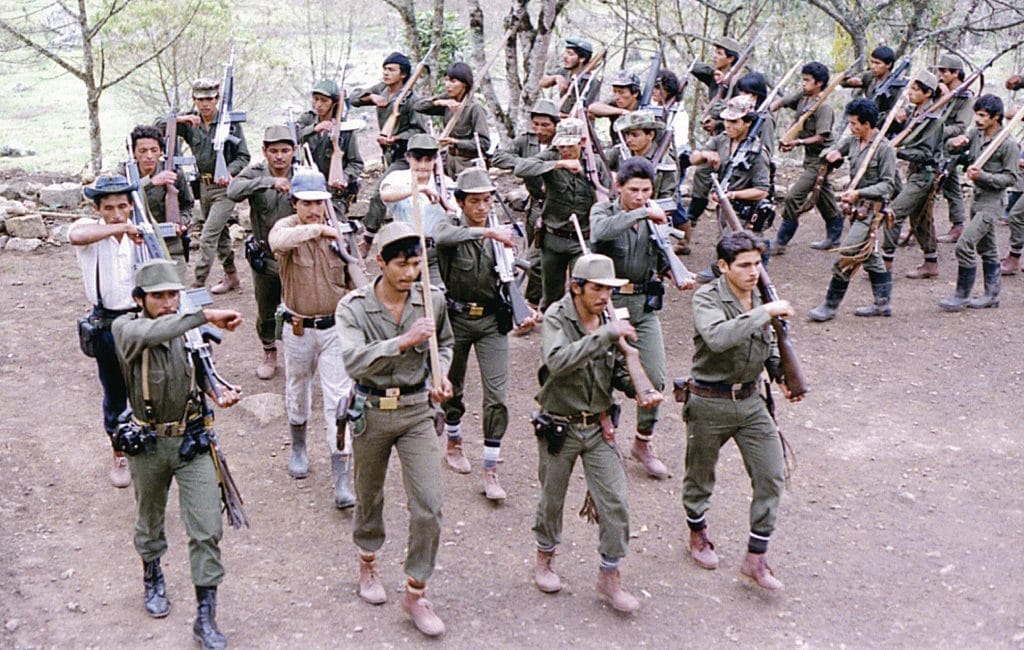
Farc fighters training at a camp in the Colombian mountains during the 1980s
A 2013 report by Colombia’s National Centre of Historical Memory concluded that 220,000 people had died in the violence since 1958. Most deaths were attributed to far-right paramilitaries; most economic damage to far-left guerrillas.
Although peace deals have seen significant demobilisation and reduced conflict violence, demobilised militias have given birth to legacy groups like the Clan del Golfo and numerous dissident Farc troops, which continue to hold territory, dominate narco-trafficking and fight both one another and government forces, with entire communities trapped in the crossfire.
Many other LGBTQ collectives want to get to know us, to know the tough bastards who said ‘Yes, we are gay’ to the paramilitaries”
Colombia’s peace agreements have gained international recognition for being the first to bring victims to the negotiating table. Numerous processes of truth and reconciliation have been established, including a victim support and reparations unit and a commission for historical truth. There’s also a transitional court, set up to investigate and prosecute crimes which took place during the conflict. It made its first indictment, against the Farc, on 28th January 2021.
In 2020, the remaining members of Sardino’s collective gained recognition by the victim-support unit for the war crimes committed against them, along with two groups from other parts of Colombia. It was the first time that crimes against LGBTQ people have been classified as war crimes. The state funded the production of the collective’s book about Sardino, and its members are eligible for compensation from the unit, in recognition that the crimes against them were part of a strategy of war. They are awaiting a final verdict on the level of compensation.
In another major achievement, the collective have submitted a report to the transitional court itself about the human rights abuses they faced during the conflict. The report was the first of its kind, revealing the systematic nature of violence against the LGBTQ community in Colombia during the civil conflict. “The judges listening to our stories cried as we spoke. They had no idea that LGBTQ people had been attacked so fiercely here,” says Mincho.
The visibility of the Chrysalis Collective in pursuing justice has made waves in Colombia. “Many other LGBTQ collectives want to get to know us, to know the tough bastards who said ‘Yes, we are gay’ to the paramilitaries. That’s our story. That was our resistance,” Mincho says. “We are opening the space for other groups to tell their stories.”
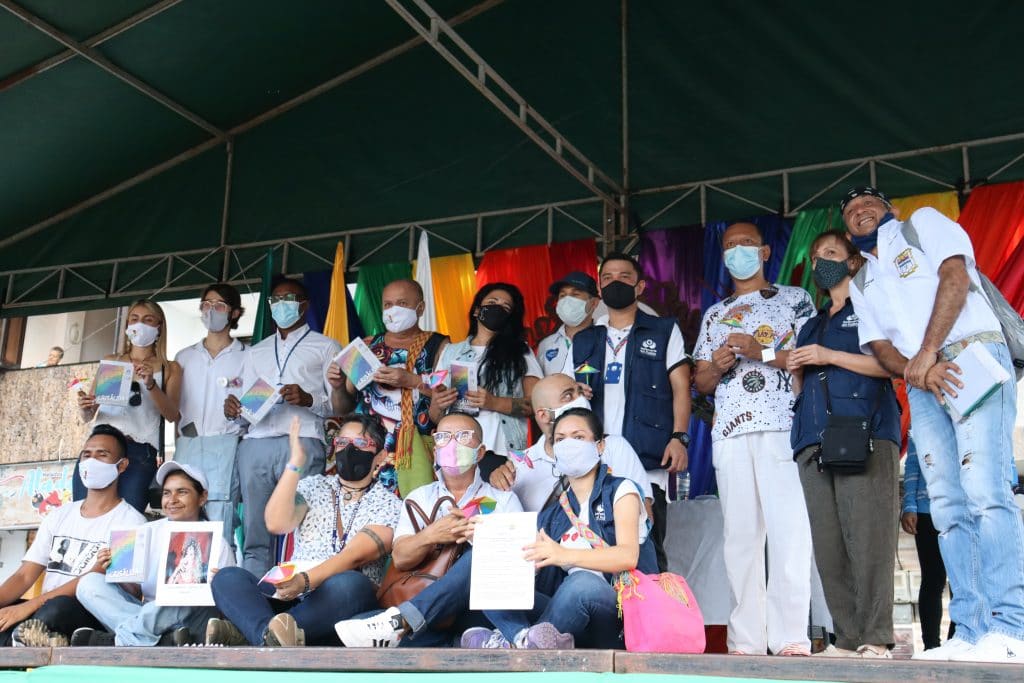
Members of the collective gather at the launch of Chrysalis, with Sardino’s friend Jhon Jairo Botero pictured far right
Colombia’s gay communities are coming together to testify about the persecution they suffered and momentum is building, with ten reports at the transitional court on violence against women and LGBTQ people, and another five coming this year. There are hopes that the court will open a thematic investigation, known as a ‘macro case’, on the issue of violence motivated by gender and sexuality. Alfred Bula, the lawyer who worked with members of the Chrysalis Collective on their transitional court report, tells me such a case would be “a huge step”.
But the transitional court has come under political attack from the hard right in Colombia – which includes the ruling Democratic Centre party. The country’s current president, Iván Duque, and the founder of the ruling party, former president Álvaro Uribe, led the ‘No’ campaign against the peace agreement of 2016, and have proposed a series of fundamental changes designed to weaken the court. In 2021, Uribe even called for a referendum designed to do away with it entirely. The hard right’s rejection of what it dismisses as ‘gender ideology’ is a further obstacle to progress for women and LGBTQ groups. It also claims that the court provides a form of impunity for former guerrillas, with its focus on restorative rather than retributive justice.
Duque’s reticent implementation of the peace deal during his presidency (less than 25 percent of it has been enacted to date) has been widely blamed for violence intensifying across the country. In 2020, there were more than 90 massacres in Colombia, the highest figure since the 2016 peace deal, and former Farc combatants continue to be targeted. More than 60 were killed last year. Thousands of Colombians continue to suffer under occupation and control of armed groups.
“Numerous sectors of Colombian politics have intentionally tried to derail the transitional court,” says Bula. “There are truths which parts of the country don’t want to come out – links between certain politicians and members of the elite with armed groups – as well as companies and whole industries.” Uribe himself, along with various members of his family, has been linked to the formation of paramilitary groups and is currently charged with witness tampering in a related investigation.
After its years shut away, the Chrysalis Collective is emerging again: today there are around 90 members of the group, with a committee of 20. There is strong representation in local administrative roles, healthcare and the arts, and three members have been voted into posts in local government – a huge feat in rural Colombia.
Chrysalis’s second protagonist and close friend of Sardino, Jhon Jairo Botero, is among them. With his trademark blue bandana, he was a core part of the dances and pageants during the collective’s heyday. “That group of friends we had back then – we are still in contact, there was something there which hasn’t been lost,” he says. “We see one another still and talk and laugh about those times.”

Jhon Jairo Botero
Sitting at his desk in the local authority offices, Botero tells me about his journey to government. “I got the most votes of any municipal councillor in the history of San Rafael: it was such a huge vote of confidence. We celebrated so hard that night,” he says. But his ambitions do not stop there. “One day I want to be mayor. That’s the plan. I would do so much. My mayorship would be truly inclusive,” he says.
Being an activist in Colombia is still extremely dangerous – more than 300 social leaders and human rights defenders were assassinated in 2020 alone, prompting UN calls for urgent action. Botero’s job and his position as a leading member of the Chrysalis Collective leave him doubly exposed. “We were – and still are – in danger,” he says. “There’s a lot left to do, and we expect plenty of hardship to come. The fear isn’t gone, but San Rafael must never be what it was before – that other San Rafael which we saw and suffered during those dark years.” Despite the danger, Botero remains optimistic, both for the Chrysalis Collective and for the town. The group’s members are hoping to use reparations for the crimes committed against them to fund a community space and provide support to local LGBTQ youth.
“In another ten years, I want us to be seen as the example to follow. Those things which seemed so far away, we have made them possible,” says Botero with a beaming and entirely infectious smile. “I promise you that nobody will be able to clip our wings. The butterfly will fly again.”
Slow Journalism in your inbox, plus infographics, offers and more: sign up for the free DG newsletter. Sign me up
Thanks for signing up.
